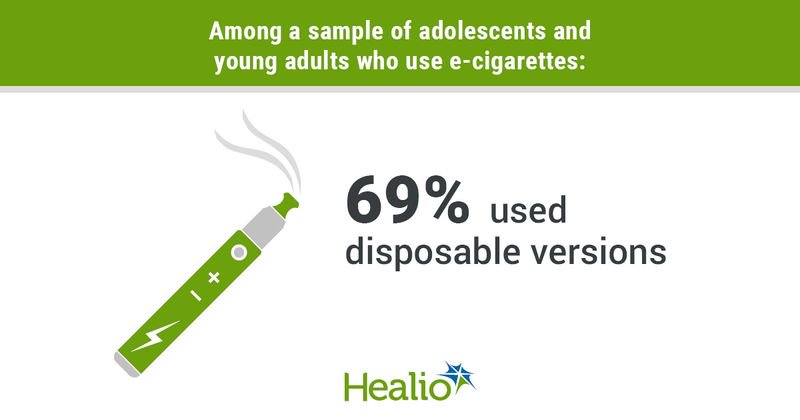In teen e-cigarette use, disposable products more habit-forming
Click Here to Manage Email Alerts
Key takeaways:
- Disposable e-cigarettes are more common among adolescents and young adults than vape pens and rechargeable pods.
- Use of disposable e-cigarettes is associated with a higher likelihood of habitual use.
Among teenagers and young adults who use e-cigarettes, disposable products were associated with longer and more frequent use than nondisposable products, according to findings published in Pediatrics.
E-cigarette sales in the United States surged nearly 47% from 2020 to 2022 to more than 22 million units per month, despite an FDA crackdown on the products, although nearly 70% of youth e-cigarette users have reported trying to quit in the past year.

According to the new study, disposable e-cigarettes are subject to fewer regulations than nondisposable products, which are often more expensive and must be charged. Disposable e-cigarettes also usually contain solutions with high concentrations of nicotine salt formulation, which could result in substantial nicotine delivery.
“Disposable e-cigarettes come in colorful packaging and designs and various sweet flavors and can be used discreetly and easily concealed, appealing to adolescents and young adults,” they wrote. “These devices are inexpensive and more convenient than nondisposable devices because they do not require recharging, purchasing e-liquid refills, and/or replacement pods.”
The researchers conducted a longitudinal study of 124 adolescents aged 14 to 17 years and 279 young adults aged 21 to 24 years, all residing in Southern California. Among both cohorts, 69% reported past 30-day disposable e-cigarette use and 31% reported using nondisposable e-cigarettes. Use of vape pens (61.8%), rechargeable pod/cartridge (42.2%), tank/mods (24.6%) and any other device type (3.7%) were also noted.
The researchers found that baseline use of disposable devices was associated with higher odds of continued e-cigarette use (adjusted OR = 1.92; 95% CI = 1.09-3.42) and a greater number of times e-cigarettes were used per day at follow-up (adjusted incidence rate ratio = 1.29; 95% CI = 1.02-1.63).
The authors suggested a need for policies that comprehensively regulate the spectrum of nicotine products used by young people, including disposable e-cigarettes.
“Our findings suggest that policies comprehensively regulating the spectrum of nicotine products used by young people, including disposable e-cigarettes, merit consideration in efforts to deter persistent patterns of adolescent and young adults’ nicotine use,” they wrote.
In a commentary accompanying the study, Robert K. Jackler, MD, and Bonnie Halpern-Felsher, PhD, both of Stanford University, suggested ways providers can avoid deceptive jargon when it comes to e-cigarettes. In particular, they said the phrases “vape juice,” “e-juice” and “e-liquid” should be avoided in favor of the term “nicotine liquid,” which “emphasizes the addictive potential of these products.”
They also discussed how Philip Morris International often promotes its e-cigarette products as “heat-not-burn” or “HeatSticks,” which the authors said would be more accurately called “tobacco sticks.”
“Heated tobacco products are often marketed as ‘smoke free,’ although their aerosols contain chemicals indicative of pyrolysis and thermogenic degradation,” they wrote. “The use of the descriptor ‘free’ in marketing a tobacco product reassures users by implying that they are free of harmful substances, which is analogous to the use of ‘fat free’ for foods.”
The authors said the use of precise tobacco product language is especially important in tobacco product regulation and legislation.
“What is needed is for responsible organizations, such as the American Academy of Pediatrics, the American Medical Association, and the American Lung Association, to convene a body of experts to formulate an alternative nomenclature framework for emerging tobacco products and promulgate its adoption for widespread use,” they wrote.
References:
Han D, et al. Pediatrics. 2024;doi:10.1542/peds.2023-063430.
Jackler RK, et al. Pediatrics. 2024;doi:10.1542/peds.2023-064501.
